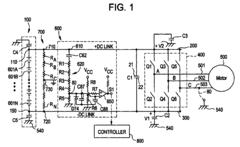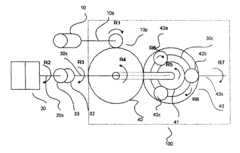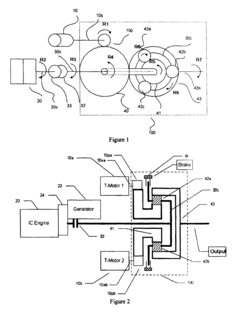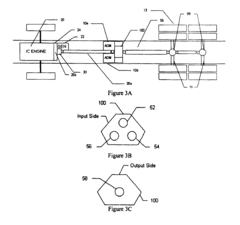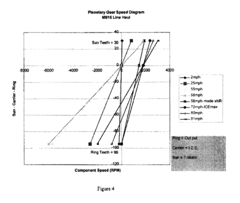How to Address HEV Reliability Challenges in Varied Terrains?
AUG 14, 202510 MIN READ
Generate Your Research Report Instantly with AI Agent
Patsnap Eureka helps you evaluate technical feasibility & market potential.
HEV Reliability Challenges and Objectives
Hybrid Electric Vehicles (HEVs) have emerged as a promising solution to reduce carbon emissions and improve fuel efficiency in the automotive industry. However, as these vehicles are deployed across diverse terrains and environmental conditions, ensuring their reliability has become a critical challenge. The primary objective of addressing HEV reliability challenges in varied terrains is to develop robust systems that can maintain optimal performance, efficiency, and longevity regardless of the operating environment.
The evolution of HEV technology has been marked by significant advancements in powertrain design, battery technology, and control systems. Despite these improvements, the reliability of HEVs in extreme conditions remains a concern. Varied terrains, including mountainous regions, desert landscapes, and urban environments, present unique challenges that can impact vehicle performance and component durability.
One of the key technical goals is to enhance the thermal management systems of HEVs to cope with temperature fluctuations in different terrains. This involves developing advanced cooling systems for batteries and power electronics that can maintain optimal operating temperatures in both hot and cold climates. Additionally, improving the efficiency of regenerative braking systems across diverse topographies is crucial for maximizing energy recovery and extending battery life.
Another critical objective is to develop intelligent power management strategies that can adapt to changing terrain conditions. This includes optimizing the distribution of power between the internal combustion engine and electric motor based on factors such as road gradient, altitude, and ambient temperature. Such adaptive systems would ensure optimal energy utilization and reduce strain on individual components.
Enhancing the durability of HEV components in harsh environments is also a primary focus. This encompasses developing more robust materials for battery casings, improving the sealing of electrical components to protect against dust and moisture, and designing suspension systems that can withstand the rigors of off-road driving while maintaining energy efficiency.
Furthermore, the integration of advanced sensors and predictive maintenance algorithms is essential for anticipating and preventing potential failures in varied terrains. By continuously monitoring vehicle performance and environmental conditions, these systems can provide early warnings and recommend maintenance actions, thereby improving overall reliability and reducing downtime.
In conclusion, addressing HEV reliability challenges in varied terrains requires a multifaceted approach that combines advancements in materials science, thermal management, power electronics, and intelligent control systems. The ultimate goal is to create HEVs that can deliver consistent performance, efficiency, and durability across a wide range of environmental conditions, thus accelerating the global adoption of this eco-friendly transportation technology.
The evolution of HEV technology has been marked by significant advancements in powertrain design, battery technology, and control systems. Despite these improvements, the reliability of HEVs in extreme conditions remains a concern. Varied terrains, including mountainous regions, desert landscapes, and urban environments, present unique challenges that can impact vehicle performance and component durability.
One of the key technical goals is to enhance the thermal management systems of HEVs to cope with temperature fluctuations in different terrains. This involves developing advanced cooling systems for batteries and power electronics that can maintain optimal operating temperatures in both hot and cold climates. Additionally, improving the efficiency of regenerative braking systems across diverse topographies is crucial for maximizing energy recovery and extending battery life.
Another critical objective is to develop intelligent power management strategies that can adapt to changing terrain conditions. This includes optimizing the distribution of power between the internal combustion engine and electric motor based on factors such as road gradient, altitude, and ambient temperature. Such adaptive systems would ensure optimal energy utilization and reduce strain on individual components.
Enhancing the durability of HEV components in harsh environments is also a primary focus. This encompasses developing more robust materials for battery casings, improving the sealing of electrical components to protect against dust and moisture, and designing suspension systems that can withstand the rigors of off-road driving while maintaining energy efficiency.
Furthermore, the integration of advanced sensors and predictive maintenance algorithms is essential for anticipating and preventing potential failures in varied terrains. By continuously monitoring vehicle performance and environmental conditions, these systems can provide early warnings and recommend maintenance actions, thereby improving overall reliability and reducing downtime.
In conclusion, addressing HEV reliability challenges in varied terrains requires a multifaceted approach that combines advancements in materials science, thermal management, power electronics, and intelligent control systems. The ultimate goal is to create HEVs that can deliver consistent performance, efficiency, and durability across a wide range of environmental conditions, thus accelerating the global adoption of this eco-friendly transportation technology.
Market Analysis for Terrain-Adaptive HEVs
The market for terrain-adaptive Hybrid Electric Vehicles (HEVs) is experiencing significant growth, driven by increasing demand for versatile and eco-friendly transportation solutions across diverse geographical regions. As urbanization expands and infrastructure development reaches remote areas, consumers are seeking vehicles that can seamlessly transition between city streets and challenging terrains while maintaining optimal performance and reliability.
The global HEV market is projected to expand rapidly in the coming years, with terrain-adaptive models poised to capture a substantial share. This growth is fueled by several factors, including stricter emissions regulations, rising fuel costs, and growing environmental consciousness among consumers. Additionally, the increasing popularity of outdoor recreational activities and adventure tourism is creating a niche market for vehicles capable of handling varied terrains without compromising on fuel efficiency or environmental impact.
Geographically, North America and Europe currently lead the market for terrain-adaptive HEVs, owing to their well-established automotive industries, advanced infrastructure, and consumer preference for SUVs and crossover vehicles. However, emerging markets in Asia-Pacific and Latin America are showing promising growth potential, driven by rapid urbanization, improving road infrastructure, and rising disposable incomes.
The market landscape is characterized by intense competition among established automakers and new entrants specializing in electric and hybrid technologies. Key players are investing heavily in research and development to enhance the reliability and performance of HEVs in diverse terrains, focusing on advanced powertrain systems, intelligent terrain-response mechanisms, and robust suspension technologies.
Consumer preferences are shifting towards vehicles that offer a balance of performance, efficiency, and versatility. There is a growing demand for HEVs that can provide superior fuel economy in urban settings while maintaining the capability to navigate challenging off-road conditions. This trend is particularly evident in regions with varied topography, where consumers require vehicles that can adapt to both city driving and rugged terrains.
The commercial sector also presents significant opportunities for terrain-adaptive HEVs, particularly in industries such as agriculture, forestry, and mining, where vehicles must operate efficiently in harsh environments. Fleet operators are increasingly recognizing the long-term cost benefits and reduced environmental impact of hybrid technologies, driving adoption in these sectors.
As the market for terrain-adaptive HEVs continues to evolve, manufacturers are focusing on addressing key challenges such as battery performance in extreme conditions, durability of electric components in harsh environments, and optimizing energy management systems for varied terrains. Overcoming these challenges will be crucial for capturing market share and meeting the diverse needs of consumers across different geographical and operational contexts.
The global HEV market is projected to expand rapidly in the coming years, with terrain-adaptive models poised to capture a substantial share. This growth is fueled by several factors, including stricter emissions regulations, rising fuel costs, and growing environmental consciousness among consumers. Additionally, the increasing popularity of outdoor recreational activities and adventure tourism is creating a niche market for vehicles capable of handling varied terrains without compromising on fuel efficiency or environmental impact.
Geographically, North America and Europe currently lead the market for terrain-adaptive HEVs, owing to their well-established automotive industries, advanced infrastructure, and consumer preference for SUVs and crossover vehicles. However, emerging markets in Asia-Pacific and Latin America are showing promising growth potential, driven by rapid urbanization, improving road infrastructure, and rising disposable incomes.
The market landscape is characterized by intense competition among established automakers and new entrants specializing in electric and hybrid technologies. Key players are investing heavily in research and development to enhance the reliability and performance of HEVs in diverse terrains, focusing on advanced powertrain systems, intelligent terrain-response mechanisms, and robust suspension technologies.
Consumer preferences are shifting towards vehicles that offer a balance of performance, efficiency, and versatility. There is a growing demand for HEVs that can provide superior fuel economy in urban settings while maintaining the capability to navigate challenging off-road conditions. This trend is particularly evident in regions with varied topography, where consumers require vehicles that can adapt to both city driving and rugged terrains.
The commercial sector also presents significant opportunities for terrain-adaptive HEVs, particularly in industries such as agriculture, forestry, and mining, where vehicles must operate efficiently in harsh environments. Fleet operators are increasingly recognizing the long-term cost benefits and reduced environmental impact of hybrid technologies, driving adoption in these sectors.
As the market for terrain-adaptive HEVs continues to evolve, manufacturers are focusing on addressing key challenges such as battery performance in extreme conditions, durability of electric components in harsh environments, and optimizing energy management systems for varied terrains. Overcoming these challenges will be crucial for capturing market share and meeting the diverse needs of consumers across different geographical and operational contexts.
Current HEV Reliability Issues in Diverse Terrains
Hybrid Electric Vehicles (HEVs) face significant reliability challenges when operating in diverse terrains. These issues stem from the complex interplay between traditional internal combustion engines and electric powertrains, exacerbated by varying environmental conditions. One of the primary concerns is battery performance and longevity in extreme temperatures. In cold climates, battery efficiency decreases, reducing the vehicle's electric range and overall fuel economy. Conversely, high temperatures can accelerate battery degradation, leading to reduced capacity and shorter lifespan.
Powertrain components, particularly the electric motor and power electronics, are also susceptible to reliability issues in harsh environments. Dust, moisture, and temperature fluctuations can compromise the integrity of these systems, potentially leading to premature failures. The regenerative braking system, a key feature of HEVs, may experience reduced efficiency in mountainous terrains due to increased thermal stress on components.
Suspension and chassis systems face unique challenges in varied terrains. The additional weight of battery packs and electric components alters the vehicle's center of gravity, potentially affecting handling and stability. This is particularly noticeable in off-road conditions or on poorly maintained roads, where the increased stress on suspension components can lead to accelerated wear and potential failures.
The integration of complex control systems in HEVs presents another reliability concern. These systems must continuously optimize power distribution between the electric motor and internal combustion engine while adapting to changing terrain conditions. Software glitches or sensor failures can lead to suboptimal performance or, in severe cases, system malfunctions that compromise vehicle safety and efficiency.
Thermal management systems in HEVs are crucial for maintaining optimal operating temperatures across various components. In diverse terrains, these systems are put under significant stress, particularly when transitioning between extreme temperature zones. Inadequate cooling or heating can lead to reduced efficiency, accelerated wear, and potential failures in critical components such as batteries, power electronics, and electric motors.
Lastly, the durability of electrical connections and wiring harnesses is a concern in varied terrains. Vibrations, temperature cycles, and exposure to environmental contaminants can lead to loose connections, corrosion, or insulation breakdown. These issues can result in intermittent electrical faults, which are often difficult to diagnose and repair, impacting the overall reliability and performance of HEVs in challenging environments.
Powertrain components, particularly the electric motor and power electronics, are also susceptible to reliability issues in harsh environments. Dust, moisture, and temperature fluctuations can compromise the integrity of these systems, potentially leading to premature failures. The regenerative braking system, a key feature of HEVs, may experience reduced efficiency in mountainous terrains due to increased thermal stress on components.
Suspension and chassis systems face unique challenges in varied terrains. The additional weight of battery packs and electric components alters the vehicle's center of gravity, potentially affecting handling and stability. This is particularly noticeable in off-road conditions or on poorly maintained roads, where the increased stress on suspension components can lead to accelerated wear and potential failures.
The integration of complex control systems in HEVs presents another reliability concern. These systems must continuously optimize power distribution between the electric motor and internal combustion engine while adapting to changing terrain conditions. Software glitches or sensor failures can lead to suboptimal performance or, in severe cases, system malfunctions that compromise vehicle safety and efficiency.
Thermal management systems in HEVs are crucial for maintaining optimal operating temperatures across various components. In diverse terrains, these systems are put under significant stress, particularly when transitioning between extreme temperature zones. Inadequate cooling or heating can lead to reduced efficiency, accelerated wear, and potential failures in critical components such as batteries, power electronics, and electric motors.
Lastly, the durability of electrical connections and wiring harnesses is a concern in varied terrains. Vibrations, temperature cycles, and exposure to environmental contaminants can lead to loose connections, corrosion, or insulation breakdown. These issues can result in intermittent electrical faults, which are often difficult to diagnose and repair, impacting the overall reliability and performance of HEVs in challenging environments.
Existing Terrain-Specific HEV Reliability Approaches
01 Thermal management systems for HEV reliability
Efficient thermal management systems are crucial for maintaining the reliability of hybrid electric vehicles. These systems help regulate the temperature of critical components such as batteries, electric motors, and power electronics. Proper thermal management ensures optimal performance, extends component lifespan, and enhances overall vehicle reliability.- Thermal management systems for HEV reliability: Efficient thermal management systems are crucial for maintaining the reliability of hybrid electric vehicles. These systems help regulate the temperature of critical components such as batteries, electric motors, and power electronics. Proper thermal management ensures optimal performance, extends component lifespan, and enhances overall vehicle reliability.
- Battery management and monitoring for HEV reliability: Advanced battery management and monitoring systems play a vital role in ensuring the reliability of hybrid electric vehicles. These systems oversee battery health, state of charge, and performance, optimizing energy usage and preventing potential failures. Effective battery management contributes to improved vehicle longevity and dependability.
- Fault detection and diagnostics in HEVs: Sophisticated fault detection and diagnostic systems are essential for maintaining HEV reliability. These systems continuously monitor vehicle components, identify potential issues, and provide early warnings to prevent major failures. Timely detection and diagnosis of faults help in scheduling preventive maintenance, reducing downtime, and enhancing overall vehicle reliability.
- Powertrain optimization for HEV reliability: Optimizing the powertrain system is crucial for improving HEV reliability. This includes enhancing the integration of internal combustion engines with electric motors, developing more efficient power distribution strategies, and implementing advanced control algorithms. Well-optimized powertrains contribute to better energy efficiency, reduced wear and tear, and increased overall vehicle reliability.
- Materials and component durability in HEVs: The use of advanced materials and durable components is essential for enhancing HEV reliability. This includes the development of high-performance materials for batteries, electric motors, and power electronics, as well as the implementation of robust designs for critical components. Improved material selection and component durability contribute to extended vehicle lifespan and increased reliability under various operating conditions.
02 Battery management and protection for HEVs
Advanced battery management systems are essential for ensuring the reliability of hybrid electric vehicles. These systems monitor and control battery performance, state of charge, and health. They also implement protective measures against overcharging, over-discharging, and thermal runaway, thereby enhancing the longevity and safety of the battery pack.Expand Specific Solutions03 Fault detection and diagnostics in HEVs
Sophisticated fault detection and diagnostic systems play a crucial role in maintaining HEV reliability. These systems continuously monitor various vehicle components and subsystems, detecting potential issues early and providing timely alerts. This proactive approach helps prevent major failures and reduces downtime, improving overall vehicle reliability.Expand Specific Solutions04 Powertrain optimization for HEV reliability
Optimizing the powertrain design and control strategies is essential for enhancing HEV reliability. This includes improving the integration of internal combustion engines with electric motors, developing advanced power electronics, and implementing intelligent energy management systems. These optimizations lead to more efficient and reliable hybrid powertrains.Expand Specific Solutions05 Structural design and materials for HEV durability
Innovative structural designs and advanced materials contribute significantly to HEV reliability. This includes the use of lightweight yet durable materials, improved chassis designs, and enhanced vibration damping techniques. These advancements help reduce wear and tear, improve vehicle longevity, and enhance overall reliability under various operating conditions.Expand Specific Solutions
Key Players in HEV Reliability Solutions
The competition landscape for addressing HEV reliability challenges in varied terrains is characterized by a mature market with significant growth potential. Major players like Ford, BYD, Hyundai, and GM are investing heavily in research and development to overcome these challenges. The market is driven by increasing demand for eco-friendly vehicles and stringent emission regulations. Technological advancements in battery management systems, powertrain efficiency, and vehicle durability are key focus areas. Collaborations between automakers and academic institutions, such as Jilin University and University of Michigan, are accelerating innovation in this field. Emerging players like Chery and SAIC GM Wuling are also making strides, particularly in developing markets, intensifying the competition in this rapidly evolving sector.
Ford Global Technologies LLC
Technical Solution: Ford has developed an advanced Terrain Management System for their hybrid electric vehicles (HEVs) to address reliability challenges in varied terrains. This system utilizes intelligent sensors and algorithms to continuously monitor road conditions and adjust powertrain performance accordingly. The system incorporates multiple drive modes, including Normal, Eco, Sport, Slippery, and Deep Snow/Sand, each optimizing the hybrid powertrain for specific terrain conditions[1]. Ford's HEVs also feature an enhanced regenerative braking system that adapts to different terrains, maximizing energy recovery while maintaining vehicle stability[2]. Additionally, Ford has implemented a robust thermal management system for the battery and electric motors, ensuring optimal performance and longevity across diverse environmental conditions[3].
Strengths: Comprehensive terrain adaptation, efficient energy recovery, and advanced thermal management. Weaknesses: Potential complexity in user interface and higher initial cost compared to non-hybrid vehicles.
BYD Co., Ltd.
Technical Solution: BYD addresses HEV reliability challenges in varied terrains through its innovative Dual Mode (DM) technology. This system allows seamless switching between pure electric, series hybrid, and parallel hybrid modes based on terrain and driving conditions[1]. BYD's HEVs incorporate an intelligent all-wheel drive system that distributes power between the electric and combustion engines to optimize traction and efficiency across different terrains[2]. The company has also developed a sophisticated Battery Management System (BMS) that adapts charging and discharging strategies based on temperature, altitude, and road conditions, ensuring consistent performance and longevity of the battery pack[3]. Furthermore, BYD's HEVs feature an advanced suspension system with adaptive damping, which automatically adjusts to varying road surfaces for improved comfort and stability[4].
Strengths: Flexible powertrain modes, intelligent power distribution, and adaptive battery management. Weaknesses: Potential for increased system complexity and higher manufacturing costs.
Core Innovations in HEV Terrain Adaptation
Ground fault detection system and method
PatentInactiveEP1336528A3
Innovation
- An AC ground fault detection system that uses a switching mechanism to alternate power conductor connections at a predetermined rate, coupled with capacitors and a detector circuit to sense voltage changes relative to a reference potential, generating a fault signal when an unintended electrical path is detected, and a controller to interrupt power to prevent damage.
Power combining apparatus for hybrid electric vehicle
PatentInactiveUSRE41034E1
Innovation
- A vehicle transmission system utilizing a planetary gear set with a clutch and brake mechanism, enabling operation in three modes: mechanical, electrical, and combined, with a torque transmitting arrangement to synchronize power sources and optimize power transmission efficiency.
Environmental Impact of HEV Terrain Solutions
The environmental impact of HEV terrain solutions is a critical consideration in addressing reliability challenges across varied terrains. As hybrid electric vehicles (HEVs) become more prevalent, their interaction with diverse environments necessitates careful evaluation of ecological consequences.
One primary environmental benefit of HEVs in varied terrains is their potential for reduced emissions. In challenging landscapes, such as mountainous regions or off-road conditions, HEVs can leverage their electric motors to minimize fuel consumption and exhaust emissions during low-speed maneuvers or when additional torque is required. This capability contributes to improved air quality and reduced carbon footprint in sensitive ecosystems.
However, the environmental impact of HEV terrain solutions extends beyond emissions. The development of robust suspension systems and advanced traction control mechanisms for varied terrains often involves the use of specialized materials and manufacturing processes. These may have their own environmental implications, including resource extraction and energy-intensive production methods. Manufacturers must balance the need for durability in harsh conditions with sustainable material choices and production techniques.
Battery technology plays a crucial role in HEV performance across different terrains. While advancements in battery chemistry and management systems enhance vehicle range and reliability, the environmental cost of battery production and disposal remains a concern. Efforts to improve battery recycling and the use of more environmentally friendly materials are essential to mitigate these impacts.
The adaptation of HEVs to varied terrains also influences land use patterns and ecosystem disturbance. Improved off-road capabilities may lead to increased human access to previously undisturbed areas, potentially affecting wildlife habitats and sensitive landscapes. Conversely, the quieter operation of HEVs in electric mode can reduce noise pollution in natural environments, benefiting both wildlife and human visitors seeking a more immersive outdoor experience.
Water management is another critical aspect of HEV terrain solutions. Enhanced water fording capabilities and improved sealing technologies protect vital components from moisture and contaminants in wet or muddy conditions. These advancements not only improve vehicle reliability but also reduce the risk of fluid leaks and environmental contamination in aquatic ecosystems.
As HEV technology evolves to meet the challenges of varied terrains, the integration of regenerative braking systems optimized for diverse landscapes presents both opportunities and challenges. While these systems can recover energy during descents and improve overall efficiency, their effectiveness and environmental impact may vary depending on terrain characteristics and driving patterns.
In conclusion, addressing HEV reliability challenges in varied terrains requires a holistic approach that considers both vehicle performance and environmental stewardship. The development of terrain-specific solutions must be balanced with ecological considerations to ensure that the benefits of HEV technology are realized without compromising the integrity of diverse ecosystems.
One primary environmental benefit of HEVs in varied terrains is their potential for reduced emissions. In challenging landscapes, such as mountainous regions or off-road conditions, HEVs can leverage their electric motors to minimize fuel consumption and exhaust emissions during low-speed maneuvers or when additional torque is required. This capability contributes to improved air quality and reduced carbon footprint in sensitive ecosystems.
However, the environmental impact of HEV terrain solutions extends beyond emissions. The development of robust suspension systems and advanced traction control mechanisms for varied terrains often involves the use of specialized materials and manufacturing processes. These may have their own environmental implications, including resource extraction and energy-intensive production methods. Manufacturers must balance the need for durability in harsh conditions with sustainable material choices and production techniques.
Battery technology plays a crucial role in HEV performance across different terrains. While advancements in battery chemistry and management systems enhance vehicle range and reliability, the environmental cost of battery production and disposal remains a concern. Efforts to improve battery recycling and the use of more environmentally friendly materials are essential to mitigate these impacts.
The adaptation of HEVs to varied terrains also influences land use patterns and ecosystem disturbance. Improved off-road capabilities may lead to increased human access to previously undisturbed areas, potentially affecting wildlife habitats and sensitive landscapes. Conversely, the quieter operation of HEVs in electric mode can reduce noise pollution in natural environments, benefiting both wildlife and human visitors seeking a more immersive outdoor experience.
Water management is another critical aspect of HEV terrain solutions. Enhanced water fording capabilities and improved sealing technologies protect vital components from moisture and contaminants in wet or muddy conditions. These advancements not only improve vehicle reliability but also reduce the risk of fluid leaks and environmental contamination in aquatic ecosystems.
As HEV technology evolves to meet the challenges of varied terrains, the integration of regenerative braking systems optimized for diverse landscapes presents both opportunities and challenges. While these systems can recover energy during descents and improve overall efficiency, their effectiveness and environmental impact may vary depending on terrain characteristics and driving patterns.
In conclusion, addressing HEV reliability challenges in varied terrains requires a holistic approach that considers both vehicle performance and environmental stewardship. The development of terrain-specific solutions must be balanced with ecological considerations to ensure that the benefits of HEV technology are realized without compromising the integrity of diverse ecosystems.
Regulatory Framework for HEV Reliability Standards
The regulatory framework for HEV reliability standards plays a crucial role in addressing the challenges faced by Hybrid Electric Vehicles (HEVs) in varied terrains. As HEVs become increasingly prevalent in diverse environments, governments and regulatory bodies worldwide are developing and implementing comprehensive standards to ensure their reliability and safety.
At the international level, organizations such as the United Nations Economic Commission for Europe (UNECE) have established regulations like UN Regulation No. 100, which focuses on the safety requirements for electric power trains. These regulations provide a foundation for national and regional standards, ensuring a baseline of reliability across different jurisdictions.
In the United States, the National Highway Traffic Safety Administration (NHTSA) and the Environmental Protection Agency (EPA) collaborate to set standards for HEV reliability. The Federal Motor Vehicle Safety Standards (FMVSS) include specific requirements for hybrid and electric vehicles, addressing issues such as battery safety, electrical isolation, and crash protection.
The European Union has implemented a series of regulations under the European Community Whole Vehicle Type Approval (ECWVTA) system. These regulations cover various aspects of HEV reliability, including electromagnetic compatibility, battery performance, and regenerative braking systems. The EU's approach emphasizes the importance of adapting reliability standards to different terrains and driving conditions.
In Asia, countries like Japan and China have developed their own regulatory frameworks. Japan's Ministry of Land, Infrastructure, Transport and Tourism (MLIT) has established stringent standards for HEV reliability, particularly focusing on battery durability and performance in extreme weather conditions. China's Ministry of Industry and Information Technology (MIIT) has implemented regulations that address the unique challenges posed by the country's diverse geography and climate.
Many of these regulatory frameworks incorporate terrain-specific considerations. For instance, standards may require HEVs to undergo testing in various environmental conditions, including extreme temperatures, high altitudes, and challenging road surfaces. This approach ensures that HEVs can maintain reliability across a wide range of terrains.
To address the specific challenges of varied terrains, regulatory bodies are increasingly adopting performance-based standards rather than prescriptive ones. This shift allows manufacturers to innovate and develop solutions tailored to different environments while still meeting overarching reliability requirements.
As HEV technology continues to evolve, regulatory frameworks are adapting to keep pace. Many jurisdictions are implementing regular review processes to update their standards, ensuring they remain relevant and effective in addressing emerging reliability challenges. This dynamic approach to regulation is essential for supporting the ongoing development and adoption of HEVs across diverse terrains and driving conditions.
At the international level, organizations such as the United Nations Economic Commission for Europe (UNECE) have established regulations like UN Regulation No. 100, which focuses on the safety requirements for electric power trains. These regulations provide a foundation for national and regional standards, ensuring a baseline of reliability across different jurisdictions.
In the United States, the National Highway Traffic Safety Administration (NHTSA) and the Environmental Protection Agency (EPA) collaborate to set standards for HEV reliability. The Federal Motor Vehicle Safety Standards (FMVSS) include specific requirements for hybrid and electric vehicles, addressing issues such as battery safety, electrical isolation, and crash protection.
The European Union has implemented a series of regulations under the European Community Whole Vehicle Type Approval (ECWVTA) system. These regulations cover various aspects of HEV reliability, including electromagnetic compatibility, battery performance, and regenerative braking systems. The EU's approach emphasizes the importance of adapting reliability standards to different terrains and driving conditions.
In Asia, countries like Japan and China have developed their own regulatory frameworks. Japan's Ministry of Land, Infrastructure, Transport and Tourism (MLIT) has established stringent standards for HEV reliability, particularly focusing on battery durability and performance in extreme weather conditions. China's Ministry of Industry and Information Technology (MIIT) has implemented regulations that address the unique challenges posed by the country's diverse geography and climate.
Many of these regulatory frameworks incorporate terrain-specific considerations. For instance, standards may require HEVs to undergo testing in various environmental conditions, including extreme temperatures, high altitudes, and challenging road surfaces. This approach ensures that HEVs can maintain reliability across a wide range of terrains.
To address the specific challenges of varied terrains, regulatory bodies are increasingly adopting performance-based standards rather than prescriptive ones. This shift allows manufacturers to innovate and develop solutions tailored to different environments while still meeting overarching reliability requirements.
As HEV technology continues to evolve, regulatory frameworks are adapting to keep pace. Many jurisdictions are implementing regular review processes to update their standards, ensuring they remain relevant and effective in addressing emerging reliability challenges. This dynamic approach to regulation is essential for supporting the ongoing development and adoption of HEVs across diverse terrains and driving conditions.
Unlock deeper insights with Patsnap Eureka Quick Research — get a full tech report to explore trends and direct your research. Try now!
Generate Your Research Report Instantly with AI Agent
Supercharge your innovation with Patsnap Eureka AI Agent Platform!
